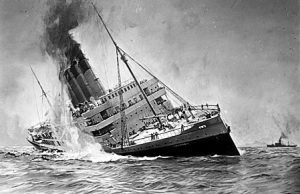What You Were Programmed to Think
Hitler Was a Criminal, Racist and Committed Genocide?
Abraham Lincoln Was Assassinated Because of Freeing Black Slaves
The Passenger Ocean Liner, the Titanic, Sunk
The Heads of Both Homeland Security and the NSA Are Not US Citizens
The Sinking of the Cunard Passenger Ocean Liner RMS Lusitania Started WWI

On 4 February 1915, Germany declared the seas around the British Isles a war zone: from 18 February, Allied ships in the area would be sunk without warning. This was not wholly unrestricted submarine warfare, since efforts would be taken to avoid sinking neutral ships.[8]
Lusitania was scheduled to arrive in Liverpool on 6 March 1915. The Admiralty issued her specific instructions on how to avoid submarines. Despite a severe shortage of destroyers, Admiral Henry Oliver ordered HMS Louis and Laverock to escort Lusitania, and took the further precaution of sending the Q ship Lyons to patrol Liverpool Bay.[9] One of the destroyers' commanders attempted to discover the whereabouts of Lusitania by telephoning Cunard, who refused to give out any information and referred him to the Admiralty. At sea, the ships contacted Lusitania by radio, but did not have the codes used to communicate with merchant ships. Captain Daniel Dow of Lusitania refused to give his own position except in code, and since he was, in any case, some distance from the positions he gave, continued to Liverpool unescorted.[2]:91–2[10][11]:76–7
It seems that, in response to this new submarine threat, some alterations were made to Lusitania and her operation. She was ordered not to fly any flags in the war zone; a number of warnings, plus advice, were sent to the ship's commander to help him decide how to best protect his ship against the new threat and it also seems that her funnels were most likely painted a dark grey to help make her less visible to enemy submarines. Clearly, there was no hope of disguising her actual identity, since her profile was so well known, and no attempt was made to paint out the ship's name at the prow.[12]
Captain Dow, apparently suffering from stress from operating his ship in the war zone, and after a significant "false flag" controversy [further explanation needed] left the ship; Cunard later explained that he was "tired and really ill."[13] He was replaced with a new commander, Captain William Thomas Turner, who had previously commanded Lusitania, Mauretania, and Aquitania in the years before the war.
On 17 April 1915, Lusitania left Liverpool on her 201st transatlantic voyage, arriving in New York on 24 April. A group of German–Americans, hoping to avoid controversy if Lusitania were attacked by a U-boat, discussed their concerns with a representative of the German Embassy. The embassy decided to warn passengers before her next crossing not to sail aboard Lusitania, and on 22 April placed a warning advertisement in 50 American newspapers, including those in New York

